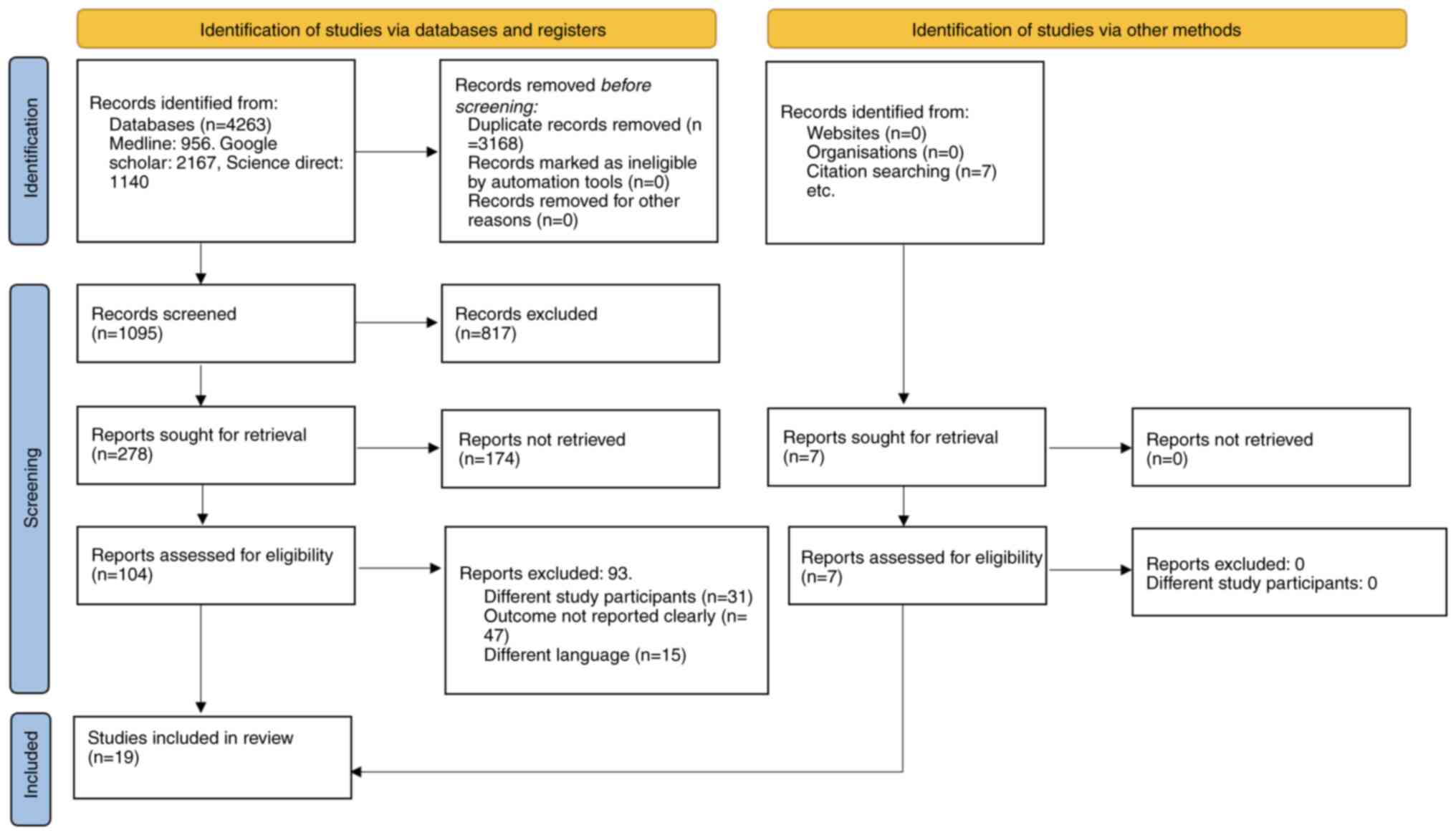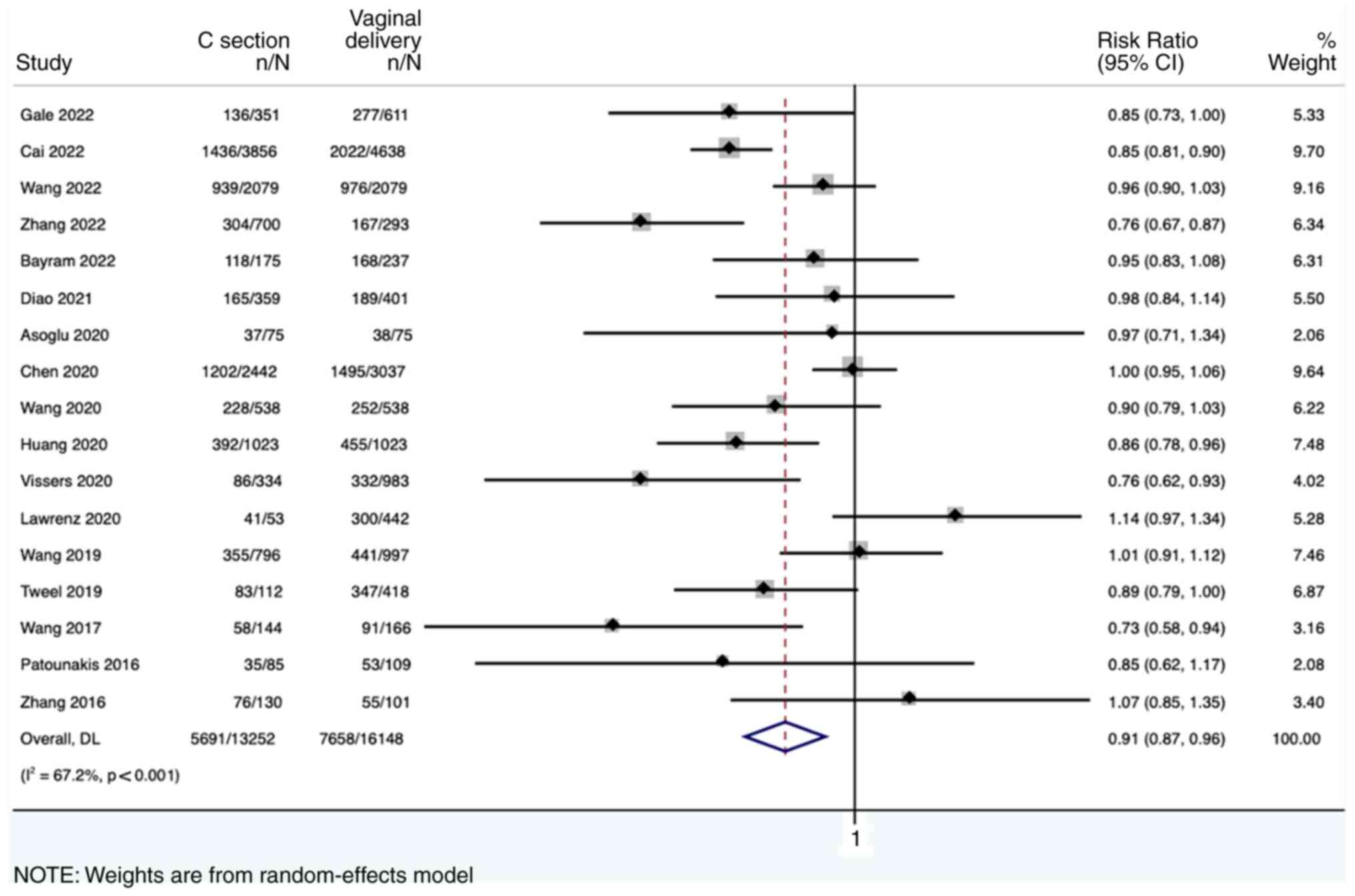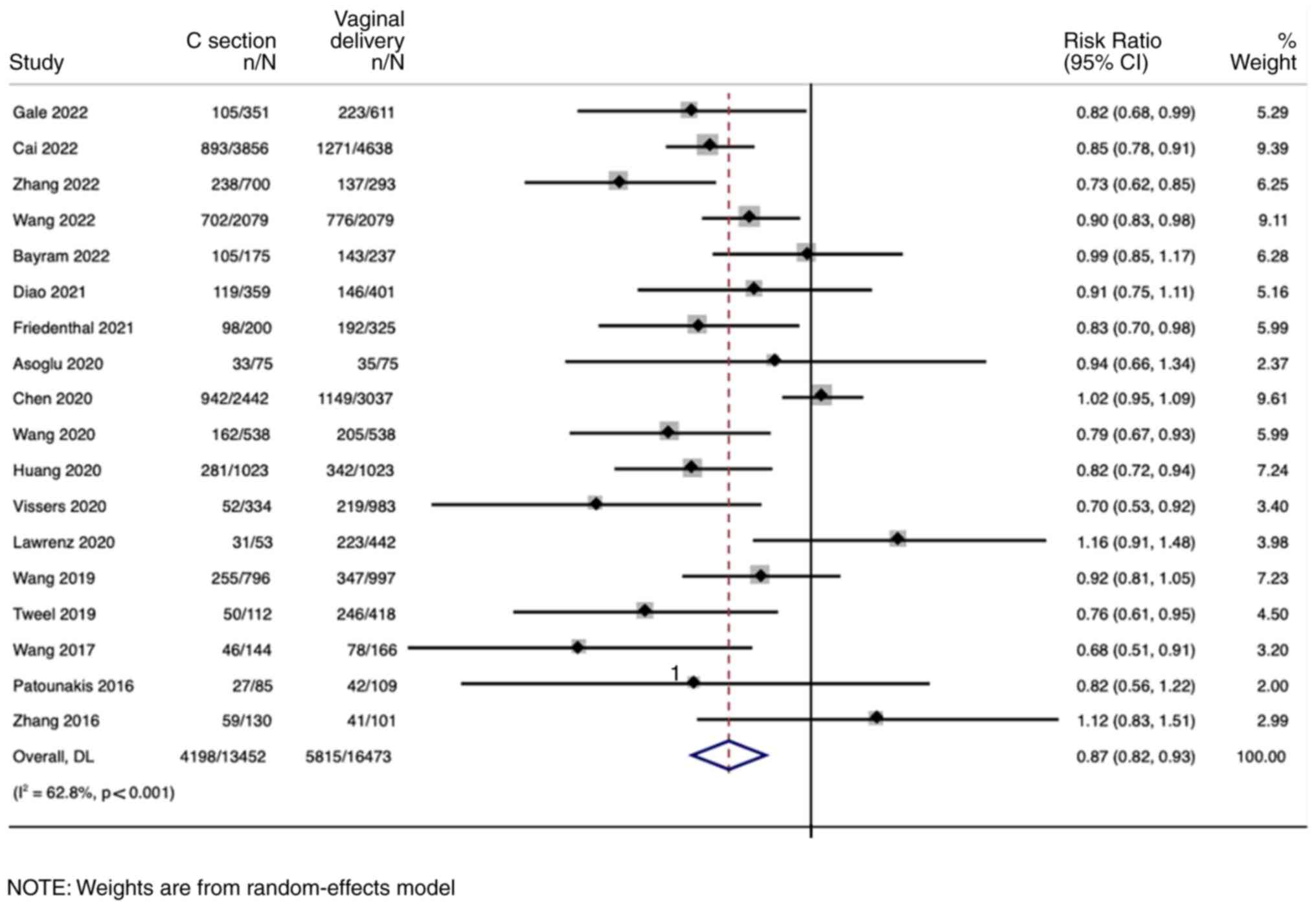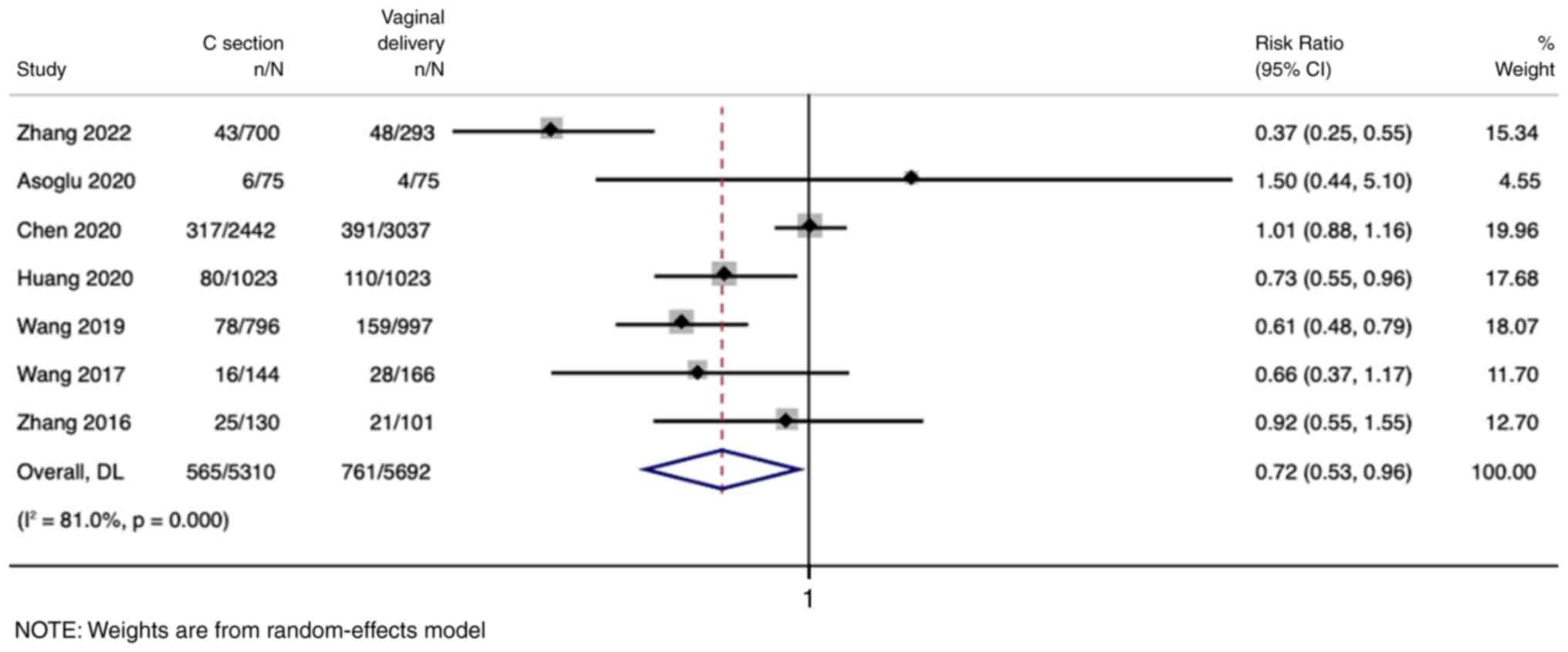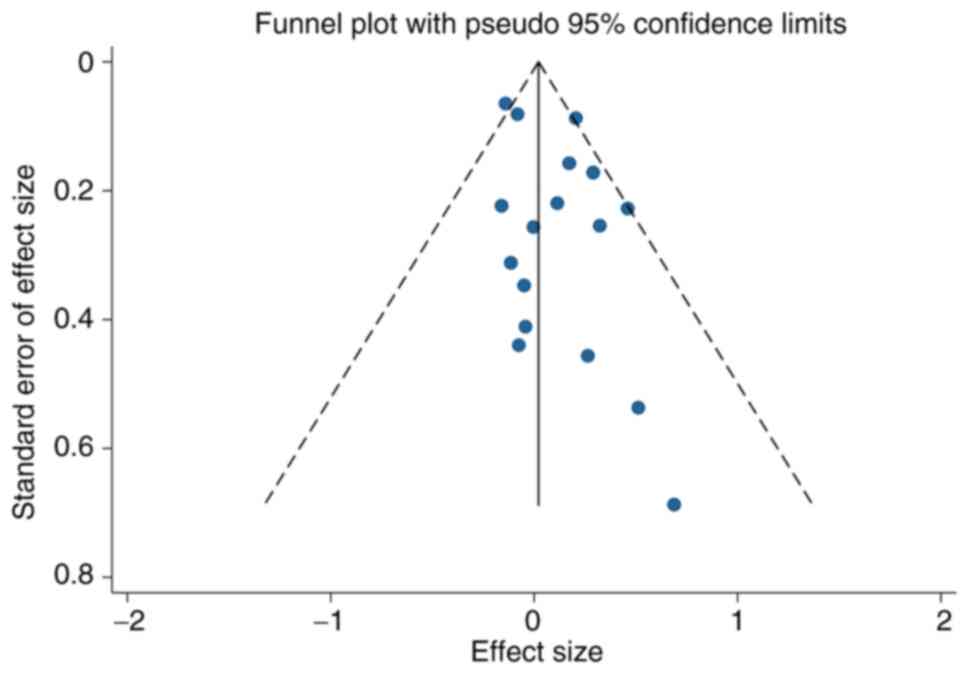Effect of previous caesarean section on reproductive and pregnancy outcomes after assisted reproductive technology: A systematic review and meta‑analysis
- Authors:
- Published online on: May 15, 2024 https://doi.org/10.3892/etm.2024.12572
- Article Number: 284
-
Copyright: © Cao et al. This is an open access article distributed under the terms of Creative Commons Attribution License.
Abstract
Introduction
The rates of caesarean section (CS) have increased globally from 7% in 1990 to 21% in 2023(1), and are particularly high in developing countries (30-35%) (2-4). Numerous studies have revealed that previous CS is associated with an increased risk of infections and postpartum haemorrhage, as well as an increased incidence of obstetric complications, such as abnormal placentation and risk of uterine rupture, in subsequent pregnancies (5). Additionally, 42-58% of women who underwent CS reported post-caesarean scar defects (PCSD), such as isthmocele (an iatrogenic defect in the myometrium at the site of a previous caesarean scar due to defective tissue healing) (6). While the incidence of PCSD is 61% in women who have had one previous CS, it reaches 100% in women who have had at least three CS (5,7).
Correlation between previous CS, fertility and other pregnancy outcomes is still not clear. While a previous study reported reduced fertility and live birth rates subsequent to previous CS (8), another study claimed that previous CS has only marginal impact on future fertility and that clinical and societal factors, leading to higher CS rates, may have a greater impact on reproductive health than CS itself (9). Since the use of assisted reproductive technology (ART) continues to rise globally (10), there is an increasing need to understand the implications of previous CS for maternal and fetal health. A previous study suggested that previous CS is correlated with lower subsequent clinical pregnancy rates (CPR) and longer time to conceive compared with natural vaginal delivery (NVD) (11). However, the true impact of previous CS on subsequent pregnancies remains unclear. The latest meta-analysis exploring the same research topic by Zhao et al (12) (2021), included just seven studies and lacks a comprehensive analysis of maternal and neonatal outcomes. Thus, in the present systematic review and meta-analysis the effects of previous CS compared with normal vaginal delivery (NVD) were analysed with regard to the following: i) The reproductive outcomes such as live birth rate (LBR), biochemical pregnancy rate (BPR), clinical pregnancy rates (CPR), implantation rate (IR) and ectopic pregnancy rate (EPR); ii) pregnancy outcomes including preterm birth rate (PBR), still birth rate (SBR), miscarriage rate (MR), birth defects (BD), birth weight (BW) and multiple pregnancy rate (MPR); and iii) other outcomes such as endometrial thickness (EMT) and difficult transfer rate (DTR).
The present systematic review and meta-analysis aimed to summarize and analyse data of all reproductive, pregnancy and perinatal outcomes in women who underwent ART treatment after previous CS.
Patients and methods
Protocol registration and methodology. The present study was registered at PROSPERO (an international database of systematic review protocols; no. CRD42023468689). The latest (2020) ‘Preferred Reporting Items for Systematic Reviews and Meta-Analyses (PRISMA)’ framework was used to report the findings of the present study (13). Ethical approval was not obtained, since only information that was freely available across various databases was utilized.
Inclusion criteria. Studies that included the following were selected: i) Studies reporting on pregnant women who underwent ART; ii) studies reporting on women with previous CS and ART; iii) studies reporting on women with previous NVD and ART; iv) studies reporting various reproductive, pregnancy and neonatal outcomes; and v) analytical studies including cross sectional, prospective and retrospective observational, as well as case control studies.
Exclusion criteria. Studies with the following characteristics were excluded: i) Studies without a control group of patients who underwent vaginal birth; and ii) studies without follow-up records, with inadequate data, not peer-reviewed, and grey literature (policy reports, newsletters and working papers). In addition, only articles published in the English language across Medline (https://pubmed.ncbi.nlm.nih.gov), Google Scholar (https://scholar.google.com) and Science Direct (https://www.sciencedirect.com) databases, from inception until October 2023 were included.
Search strategy. Medical Subject Heading terms such as: ‘Previous C section’ OR ‘Previous Caesarean section’ AND ‘Previous Vaginal delivery’ AND ‘In vitro fertilisation’ OR ‘Assisted reproductive techniques’ OR ‘Embryo transfer’ AND ‘Observational studies’ OR ‘Cohort studies’ OR ‘Prospective studies’ were utilized to search in the three aforementioned databases. No geographical limitations were considered. Additionally, studies that were missed by computerised searches were examined by searching the reference lists of all qualifying articles and were included if found eligible. Two primary investigators (DC and LC) independently conducted the search and assessed the quality of individual studies. All cases of disagreements were resolved by consensus. The detailed search strategy is presented in Table SI.
Outcome parameters and operational definitions. The primary outcomes of interest were: Reproductive outcomes such as CPR, defined as the presence of an intrauterine gestational sac through ultrasound confirmation; LBR, defined as the birth of a live fetus 24 weeks after conception; EPR, defined as the presence of an extrauterine gestational sac through ultrasound confirmation; MR, defined as pregnancy loss before 12 weeks of gestation; BPR, defined as an elevated serum level of β-human chorionic gonadotropin [>5 IU/l] after 14 days; SBR, defined as the delivery of a fetus with no signs of viability/after 28 weeks; and IR. Secondary outcomes of interest were: PBR, defined as the delivery of a live fetus before 37 completed weeks; as well as EMT, BW, MPR, DTR and BD.
Data extraction and management. Relevant information such as the details of the authors, study design, duration, sample size, geographical location, inclusion criteria, embryo transfer type and relevant primary and secondary outcomes were extracted and entered in the data documentation sheet.
Statistical analysis. The extracted data were analysed using Stata 14.2 (StataCorp LLC). Each data entry was double-checked by the investigators. The effect across studies was pooled for binary outcomes through the inverse variance method using risk ratios (RR) with a 95% confidence interval (CI), and continuous outcomes as a mean difference with a 95% CI. In case of missing data, efforts were made to contact the author for necessary information, such as data pertaining to the study period, mean age distribution of cases and controls and other information necessary for assessing the quality of the studies. In all cases where it was not possible to obtain the necessary data, it was considered not reported. Pooled effect sizes were graphically represented as forest plots and publication bias was graphically represented as funnel plots and was statistically tested using Egger's test (14). P<0.05 was considered to indicate a statistically significant difference.
Assessment of heterogeneity. The I2 statistic and the Chi-square heterogeneity test were used to examine the between-study variability. Three levels of heterogeneity were identified: Mild (I2<25%), moderate (I2=25-75%) and considerable (I2>75%).
Quality of the included studies. Quality of the included studies was assessed using the Newcastle Ottawa Scale (NOS) (15). The scale assesses the quality of studies using three criteria: Ascertainment of outcome, selection and comparability of the study groups. A study may receive a maximum of one star for each numbered item in the selection and outcome categories. For comparability, a maximum of two stars may be assigned. Thus, the maximum NOS score is nine.
Results
Study selection. A total of 4,263 articles were identified by the literature search across the databases. Of these, 3,168 were removed as duplicates. Another 817 articles were excluded after screening the title and abstract. From the remaining 278 studies, 104 free full text articles were retrieved. Finally, a total of 19 articles that met eligibility criteria, were selected for the present systematic review and meta-analysis (16-34). In total, 18 studies reported on the LBR (16-33), 17 reported on the CPR (16-32), 17 on the MR (16-29,31-33), 16 on the EPR (16-29,31,32), 13 on the BPR (16-21,23-25,27,29,32,33), nine on the PBR (19,20,22,24,25,28,29,32,34), eight studies on the EMT (16,17,19,20,22,24,30,33), seven each on the MPR (16,19,20,23,25,28,32), SPR (19,20,22,24,26,29,32) and IR (16,19,20,24,27,32,33), five on the BW (19,20,24,31,32), three on the DTR (17,19,24) and two on the BD (20,32) respectively. The PRISMA 2020 flow diagram is explained in Fig. 1.
Characteristics of the included studies. General characteristics of the included studies are detailed in Table I. Of the 19 studies included, 11 were from China, two were from the Netherlands and the USA, and one study each from Turkey, Canada, Germany and UAE. All studies reported results in English. The sample size of the included studies ranged between 150 to 9,124. Most (17/19) studies were retrospective cohort studies, one was a prospective cohort study and one was a retrospective case control study.
Excluded studies. Of the 104 full-text articles extracted, 93 studies were excluded during secondary screening. Specifically, 31 were excluded as they had mixed study participants groups, 47 did not report the outcome clearly and 15 were published in languages other than English.
Reproductive outcomes across the study groups. A total of 17 studies (n=29,400; CS=13,252 and NVD=16,148) reported on the CPR. It was observed that women with previous CS had a 9% lower CPR compared with women who had previous NVD (pooled RR of 0.91, 95% CI: 0.87-0.96, with high heterogeneity I2=67.2; P<0.001) (Fig. 2). Furthermore, 18 studies (n=29,925; CS=13,452 and NVD=16,473) reported on the LBR. It was observed that women with previous CS had a 13% lower LBR compared with women who had previous NVD (pooled RR of 0.87, 95% CI: 0.82-0.93, with high heterogeneity I2=62.8; P<0.001) (Fig. 3). Next, seven studies (n=21,439; CS=9,299 and NVD=12,140) reported on the IR. Women with previous CS had an 11% lower IR compared with women with previous NVD (pooled RR of 0.89, 95% CI: 0.81-0.99, with high heterogeneity I2=76.1; P<0.001) (Fig. S1). However, there was no significant difference in the EPR (pooled RR of 1.15, 95% CI: 0.87-1.51, with no heterogeneity I2=0; P=0.850) (Fig. S2) and BPR (pooled RR of 0.95, 95% CI: 0.84-1.07, with high heterogeneity I2=94.2; P<0.001) (Fig. S3). Publication bias was assessed only for four of the reproductive outcomes (BPR, CPR, EPR and LBR) that were reported by >10 studies. No publication bias was reported for outcomes such as CPR (Egger coefficient, 0.42; P=0.63) (Fig. S4), LBR (Egger coefficient, 1.03; P=0.20) (Fig. S5), BPR (Egger coefficient, -1.0; P=0.66) (Fig. S6) and EPR (Egger coefficient, 0.41; P=0.30) (Fig. S7).
Secondary pregnancy outcomes across the study groups. A total of seven studies (n=11,002; CS=5,310 and NVD=5,692) reported on the MPR. Women with previous CS had a 28% lower MPR compared with women who had previous NVD (pooled RR of 0.72, 95% CI: 0.53-0.96, with high heterogeneity I2=81.0; P<0.001) (Fig. 4). Furthermore, eight studies (n=6,111; CS=2,629 and NVD=3,482) reported on the EMT. Women with previous CS had -0.14 lower EMT compared with women who had previous NVD (pooled WMD of -0.14, 95% CI: -0.26 to -0.01, with no heterogeneity I2=0%; P=0.745) (Fig. S8). DTRs were reported by three studies that showed that women with previous CS had an 8-fold higher DTR compared with women with NVD (pooled RR of 8.02, 95% CI: 4.54-14.16, with no heterogeneity I2=0%; P=0.600) (Fig. S9). However, no significant difference was detected in terms of the PBR (pooled RR of 1.08, 95% CI: 0.82-1.42, with high heterogeneity I2=79.3%; P<0.001) (Fig. S10), MR (pooled RR of 1.08, 95% CI: 0.96-1.20, with moderate heterogeneity I2=32.2; P=0.098) (Fig. S11), SBR (pooled RR of 0.82, 95% CI: 0.31-2.21, with low heterogeneity I2=11.1; P=0.342) (Fig. S12), BW (pooled WMD of 17.41, 95% CI: -74 to 108.8, with moderate heterogeneity I2=59.4; P=0.043) (Fig. S13) and BD (pooled RR of 1.72, 95% CI: 0.49-5.97, with no heterogeneity I2=0%; P=0.440) (Fig. S14). Publication bias was assessed only for the MR, among the secondary pregnancy outcomes, as it had >10 studies reporting it. The absence of publication bias for the MR was noted (Egger coefficient, 0.84; P=0.08) (Fig. 5).
Risk of bias in the included studies. Table I summarizes the data on the risk of bias in the included studies, as assessed by NOS. Based on the 9-item scoring system, it was revealed that 11 studies had a score of 8, six had a score of 7 and the remaining two studies had a score of 9.
Discussion
The present meta-analysis included 19 studies that reported 13 different reproductive and pregnancy outcomes in women who underwent ART with and without a previous history of CS. The results demonstrated that women with a previous history of CS had 9, 13, 11 and 28% lower probability of CPR, LBR, IR and MPR, respectively. Additionally, previous CS was associated with an 8-fold higher DTR than previous NVD. These findings offer valuable insights into the clinical management of this unique patient population.
The rates of CS are on the rise worldwide (35), which in turn suggests that an increasing number of women with a history of previous CS will be receiving ART treatment. Previous studies showed that having a previous CS may increase the likelihood of infertility and prolong the time required to conceive (36,37). Murphy et al (10), hypothesized that this reduction in fertility might be linked to increased rates of infections, adhesions, disruption of the placental bed or other non-medical factors associated with CS, in addition to socioeconomical and cultural differences.
The results of the present study revealed a 9% lower CPR and 13% lower LBR in women with previous CS, which is consistent with the work of Zhao et al (12). It may be speculated that this effect may be explained by several possible mechanisms. The endometrium at the CS scar site has fewer blood vessels in the endometrial stroma, less leukocyte infiltration and delayed endometrial maturation as compared with the endometrium after vaginal delivery (38,39). Additionally, women with previous CS tend to have increased rates of posterior placentas during subsequent conception (40). CS also impacts the integrity of the endometrial muscle layer junction zone (41,42). In addition, a previous study discovered that in frozen-thawed embryo transfer cycles, a previous CS was linked to a lower LBR and increased MR (16).
However, it is important to note that the present analysis did not reveal significant differences in EPR, MR and BPR between women with previous CS and NVD. The results were comparable to findings by Riemma et al (43). It was observed that previous CS was associated with an 11% reduction in IR and an 8-fold higher DTR. These findings are similar to findings from previous studies (44,45) and may be explained by an anterior diverticulum, which gathers fluid and old blood developing in the lower uterus as a result of a CS incision (45). Blood that enters the uterus may prevent successful implantation (44).
The present study had several clinical implications. The findings of the present study may aid clinicians in counselling women with previous CS about the potential impact on their prospects of achieving a clinical pregnancy and live birth through ART. In addition, the findings of the present study warrant a thorough uterine anatomy evaluation before initiating ART, especially in women with previous CS, for early identification of uterine scars, adhesions and other possible complications. The findings of the present study also emphasize the importance of optimizing embryo transfer techniques in women with previous CS to enhance successful implantation.
The present review is among the very few attempts that have evaluated the impact of previous CS on a comprehensive list of reproductive and pregnancy outcomes among women with ART. The increased power of the present review due to the large sample size is another major strength.
Despite these strengths, the present study has certain limitations. One limitation is the moderate to high heterogeneity between the studies. This heterogeneity may be explained by methodological differences such as the study design, differences in treatment protocols, embryo transfer techniques and types of CS. In addition, the possibility of language bias could not be excluded as only studies published in English were included. Moreover, most included studies were historical cohorts. Therefore, it was not possible to adjust for some potential confounders such as smoking status, embryo quality, body mass index or ovarian stimulation protocols.
In conclusion, the present systematic review and meta-analysis provided comprehensive insights into the impact of previous CS on reproductive and pregnancy outcomes in women undergoing ART. The findings indicated that women with previous CS may face decreased chances of CPR, LBR and successful embryo implantation during ART. These results underscore the need for tailored counselling and management strategies for this patient population.
Supplementary Material
Forest plot showing the implantation rate across study groups. CI, confidence interval.
Forest plot showing the ectopic pregnancy rate across study groups. CI, confidence interval.
Forest plot showing the biochemical pregnancy rate across study groups. CI, confidence interval.
Funnel plot describing publication bias for studies reporting on the clinical pregnancy rate.
Funnel plot describing publication bias for studies reporting on the live birth rate.
Funnel plot describing publication bias for studies reporting on the biochemical pregnancy rate.
Funnel plot describing publication bias for studies reporting on the ectopic pregnancy rate.
Forest plot showing the endometrial thickness across study groups. SD, standard deviation; WMD, weighted mean difference; CI, confidence interval.
Forest plot showing the difficult transfer rate across study groups. CI, confidence interval.
Forest plot showing the preterm birth rate across study groups. CI, confidence interval.
Forest plot showing the miscarriage rate across study groups. CI, confidence interval.
Forest plot showing the still birth rate across study groups. CI, confidence interval.
Forest plot showing the birth weight across study groups. SD, standard deviation; WMD, weighted mean difference; CI, confidence interval.
Forest plot showing the incidence of birth defects across study groups. CI, confidence interval.
Search strategy.
Acknowledgements
Not applicable.
Funding
Funding: No funding was received.
Availability of data and materials
The data generated in the present study may be requested from the corresponding author.
Authors' contributions
DC conceived and designed the study. DC and LC collected the data and performed the literature search. DC was involved in the writing of the manuscript. All authors have read and approved the final manuscript. DC and LC confirm the authenticity of all the raw data.
Ethics approval and consent to participate
Not applicable.
Patient consent for publication
Not applicable.
Competing interests
The authors declare that they have no competing interests
References
|
Angolile CM, Max BL, Mushemba J and Mashauri HL: Global increased cesarean section rates and public health implications: A call to action. Health Sci Rep. 6(e1274)2023.PubMed/NCBI View Article : Google Scholar | |
|
Spong CY, Berghella V, Wenstrom KD, Mercer BM and Saade GR: Preventing the first cesarean delivery: Summary of a joint eunice kennedy shriver national institute of child health and human development, society for maternal-fetal medicine, and American college of obstetricians and gynecologists workshop. Obstet Gynecol. 120:1181–1193. 2012.PubMed/NCBI View Article : Google Scholar | |
|
Li HT, Luo S, Trasande L, Hellerstein S, Kang C, Li JX, Zhang Y, Liu JM and Blustein J: Geographic variations and temporal trends in cesarean delivery rates in China, 2008-2014. JAMA. 317:69–76. 2017.PubMed/NCBI View Article : Google Scholar | |
|
Rajaa S, Sujiv A and Kar SS: Risk factors for cesarean section in women of urban Puducherry, India: A matched case-control study. Int J Popul Stud. 7:66–72. 2022. | |
|
Clark EAS and Silver RM: Long-term maternal morbidity associated with repeat cesarean delivery. Am J Obstet Gynecol. 205 (Suppl):S2–S10. 2011.PubMed/NCBI View Article : Google Scholar | |
|
Wang CB, Chiu WW, Lee CY, Sun YL, Lin YH and Tseng CJ: Cesarean scar defect: Correlation between cesarean section number, defect size, clinical symptoms and uterine position. Ultrasound Obstet Gynecol. 34:85–89. 2009.PubMed/NCBI View Article : Google Scholar | |
|
Diaz SD, Jones JE, Seryakov M and Mann WJ: Uterine rupture and dehiscence: Ten-year review and case-control study. South Med J. 95:431–435. 2002.PubMed/NCBI | |
|
Kjerulff KH, Zhu J, Weisman CS and Ananth CV: First birth caesarean section and subsequent fertility: A population-based study in the USA, 2000-2008. Hum Reprod. 28:3349–3357. 2013.PubMed/NCBI View Article : Google Scholar | |
|
Gurol-Urganci I, Cromwell DA, Mahmood TA, van der Meulen JH and Templeton A: A population-based cohort study of the effect of caesarean section on subsequent fertility. Hum Reprod. 29:1320–1326. 2014.PubMed/NCBI View Article : Google Scholar | |
|
Murphy DJ, Stirrat GM and Heron J: ALSPAC Study Team. The relationship between caesarean section and subfertility in a population-based sample of 14 541 pregnancies. Hum Reprod. 17:1914–1917. 2002.PubMed/NCBI View Article : Google Scholar | |
|
Tollånes MC, Melve KK, Irgens LM and Skjaerven R: Reduced fertility after cesarean delivery: A maternal choice. Obstet Gynecol. 110:1256–1263. 2007.PubMed/NCBI View Article : Google Scholar | |
|
Zhao J, Hao J, Xu B, Wang Y and Li Y: Impact of previous caesarean section on reproductive outcomes after assisted reproductive technology: Systematic review and meta-analyses. Reprod Biomed Online. 43:197–204. 2021.PubMed/NCBI View Article : Google Scholar | |
|
Page MJ, McKenzie JE, Bossuyt PM, Boutron I, Hoffmann TC, Mulrow CD, Shamseer L, Tetzlaff JM, Akl EA, Brennan SE, et al: The PRISMA 2020 statement: An updated guideline for reporting systematic reviews. BMJ. 372(n71)2021.PubMed/NCBI View Article : Google Scholar | |
|
Egger M, Davey Smith G, Schneider M and Minder C: Bias in meta-analysis detected by a simple, graphical test. BMJ. 315:629–634. 1997.PubMed/NCBI View Article : Google Scholar | |
|
Lo CK, Mertz D and Loeb M: Newcastle-ottawa scale: Comparing reviewers' to authors' assessments. BMC Med Res Methodol. 14(45)2014.PubMed/NCBI View Article : Google Scholar | |
|
Huang J, Lin J, Cai R, Lu X, Song N, Gao H, Zhu J and Kuang Y: Effect of a prior cesarean delivery on pregnancy outcomes of frozen-thawed embryo transfer: A retrospective cohort study in a freeze-all setting. Acta Obstet Gynecol Scand. 99:1303–1310. 2020.PubMed/NCBI View Article : Google Scholar | |
|
Patounakis G, Ozcan MC, Chason RJ, Norian JM, Payson M, DeCherney AH and Yauger BJ: Impact of a prior cesarean delivery on embryo transfer: A prospective study. Fertil Steril. 106:311–316. 2016.PubMed/NCBI View Article : Google Scholar | |
|
van den Tweel MM, Klijn NF, Diaz de Pool JDN, van der Westerlaken LAJ and Louwe LA: Previous caesarean section is associated with lower subsequent in vitro fertilization live birth rates. Hum Fertil (Camb). 25:93–98. 2022.PubMed/NCBI View Article : Google Scholar | |
|
Wang YQ, Yin TL, Xu WM, Qi QR, Wang XC and Yang J: Reproductive outcomes in women with prior cesarean section undergoing in vitro fertilization: A retrospective case-control study. J Huazhong Univ Sci Technolog Med Sci. 37:922–927. 2017.PubMed/NCBI View Article : Google Scholar | |
|
Zhang N, Chen H, Xu Z, Wang B, Sun H and Hu Y: Pregnancy, delivery, and neonatal outcomes of in vitro fertilization-embryo transfer in patient with previous cesarean scar. Med Sci Monit. 22:3288–3295. 2016.PubMed/NCBI View Article : Google Scholar | |
|
Lawrenz B, Melado L, Garrido N, Coughlan C, Markova D and Fatemi H: Isthmocele and ovarian stimulation for IVF: Considerations for a reproductive medicine specialist. Hum Reprod. 35:89–99. 2020.PubMed/NCBI View Article : Google Scholar | |
|
Wang L, Yao W, Tang X, Yao H, Wei S, Huang J, Mol BWJ, Jin L, Yue J and Wang R: Fertility outcomes of IVF/ICSI after caesarean section: A cohort study. Reprod Biomed Online. 40:719–728. 2020.PubMed/NCBI View Article : Google Scholar | |
|
Asoglu MR, Celik C, Ozturk E, Cavkaytar S and Bahceci M: Impact of isthmocele on assisted reproductive treatment outcomes: An age-matched retrospective study. J Minim Invasive Gynecol. 28:1113–1120. 2021.PubMed/NCBI View Article : Google Scholar | |
|
Vissers J, Sluckin TC, van Driel-Delprat CCR, Schats R, Groot CJM, Lambalk CB, Twisk JWR and Huirne JAF: Reduced pregnancy and live birth rates after in vitro fertilization in women with previous caesarean section: A retrospective cohort study. Hum Reprod. 35:595–604. 2020.PubMed/NCBI View Article : Google Scholar | |
|
Chen T, Li B, Shi H, Bu ZQ, Zhang FQ and Su YC: Reproductive outcomes of single embryo transfer in women with previous cesarean section. Reprod Sci. 28:1049–1059. 2021.PubMed/NCBI View Article : Google Scholar | |
|
Gale J, Corran B, Bacal V, Haebe J, Nguyen V and Shmorgun D: Reduced live birth rates after embryo transfer in patients with prior cesarean delivery: A retrospective cohort study. Eur J Obstet Gynecol Reprod Biol. 271:250–254. 2022.PubMed/NCBI View Article : Google Scholar | |
|
Cai M, Pan X, Xia W, Liang X and Yang X: Intra-cavitary fluid resulted from caesarean section but not isthmocele compromised clinical pregnancy after IVF/ICSI treatment. Arch Gynecol Obstet. 306:229–237. 2022.PubMed/NCBI View Article : Google Scholar | |
|
Zhang Y, de Ziegler D, Hu X, Tai X, Han Y, Ma J, Zhang Y and Luo H: Previous caesarean delivery and the presence of caesarean scar defects could affect pregnancy outcomes after in vitro fertilization frozen-thawed embryo transfer: A retrospective cohort study. BMC Pregnancy Childbirth. 22(769)2022.PubMed/NCBI View Article : Google Scholar | |
|
Wang L, Wang J, Lu N, Liu J and Diao F: Pregnancy and perinatal outcomes of patients with prior cesarean section after a single embryo transfer in IVF/ICSI: A retrospective cohort study. Front Endocrinol (Lausanne). 13(851213)2022.PubMed/NCBI View Article : Google Scholar | |
|
Bayram A, Elkhatib I, Abdala A, Nogueira D, Melado L, Fatemi HM and Lawrenz B: ART outcome after euploid frozen embryo transfer is not affected by previous cesarean section delivery in the absence of intracavitary fluid. J Assist Reprod Genet. 39:2529–2537. 2022.PubMed/NCBI View Article : Google Scholar | |
|
Diao J, Gao G, Zhang Y, Wang X, Zhang Y, Han Y, Du A and Luo H: Caesarean section defects may affect pregnancy outcomes after in vitro fertilization-embryo transfer: A retrospective study. BMC Pregnancy Childbirth. 21(487)2021.PubMed/NCBI View Article : Google Scholar | |
|
Jacob L, Weber K, Sechet I, Macharey G, Kostev K and Ziller V: Caesarean section and its impact on fertility and time to a subsequent pregnancy in Germany: A database analysis in gynecological practices. Arch Gynecol Obstet. 294:1005–1010. 2016.PubMed/NCBI View Article : Google Scholar | |
|
Friedenthal J, Alkon-Meadows T, Hernandez-Nieto C, Gounko D, Lee JA, Copperman A and Buyuk E: The association between prior cesarean delivery and subsequent in vitro fertilization outcomes in women undergoing autologous, frozen-thawed single euploid embryo transfer. Am J Obstet Gynecol. 225:287.e1–287.e8. 2021.PubMed/NCBI View Article : Google Scholar | |
|
Lin Y, Chen Q, Huang X, Wang Z, Chen C, Chen H and Jin F: Obstetric and perinatal outcomes after assisted reproductive technology in women with cesarean scar. Front Physiol. 13(808079)2022.PubMed/NCBI View Article : Google Scholar | |
|
Rietveld AL, van Exel NJA, Cohen de Lara MC, de Groot CJM and Teunissen PW: Giving birth after caesarean: Identifying shared preferences among pregnant women using Q methodology. Women Birth. 33:273–279. 2020.PubMed/NCBI View Article : Google Scholar | |
|
Hemminki E: Impact of caesarean section on future pregnancy-a review of cohort studies. Paediatr Perinat Epidemiol. 10:366–379. 1996.PubMed/NCBI View Article : Google Scholar | |
|
O'Neill SM, Kearney PM, Kenny LC, Henriksen TB, Lutomski JE, Greene RA and Khashan AS: Caesarean delivery and subsequent pregnancy interval: A systematic review and meta-analysis. BMC Pregnancy Childbirth. 13(165)2013.PubMed/NCBI View Article : Google Scholar | |
|
Rosa F, Perugin G, Schettini D, Romano N, Romeo S, Podestà R, Guastavino A, Casaleggio A and Gandolfo N: Imaging findings of cesarean delivery complications: Cesarean scar disease and much more. Insights Imaging. 10(98)2019.PubMed/NCBI View Article : Google Scholar | |
|
Ananias P, Luenam K, Melo JP, Jose AM, Yaqub S, Turkistani A, Shah A and Mohammed L: Cesarean section: A potential and forgotten risk for abdominal wall endometriosis. Cureus. 13(e17410)2021.PubMed/NCBI View Article : Google Scholar | |
|
Tinari S, Buca D, Cali G, Timor-Tritsch I, Palacios-Jaraquemada J, Rizzo G, Lucidi A, Di Mascio D, Liberati M and D'Antonio F: Risk factors, histopathology and diagnostic accuracy in posterior placenta accreta spectrum disorders: Systematic review and meta-analysis. Ultrasound Obstet Gynecol. 57:903–909. 2021.PubMed/NCBI View Article : Google Scholar | |
|
Ben-Nagi J, Walker A, Jurkovic D, Yazbek J and Aplin JD: Effect of cesarean delivery on the endometrium. Int J Gynaecol Obstet. 106:30–34. 2009.PubMed/NCBI View Article : Google Scholar | |
|
Naji O, Daemen A, Smith A, Abdallah Y, Bradburn E, Giggens R, Chan DC, Stalder C, Ghaem-Maghami S, Timmerman D and Bourne T: Does the presence of a cesarean section scar influence the site of placental implantation and subsequent migration in future pregnancies: A prospective case-control study. Ultrasound Obstet Gynecol. 40:557–561. 2012.PubMed/NCBI View Article : Google Scholar | |
|
Riemma G, De Franciscis P, Torella M, Narciso G, La Verde M, Morlando M, Cobellis L and Colacurci N: Reproductive and pregnancy outcomes following embryo transfer in women with previous cesarean section: A systematic review and meta-analysis. Acta Obstet Gynecol Scand. 100:1949–1960. 2021.PubMed/NCBI View Article : Google Scholar | |
|
Tanimura S, Funamoto H, Hosono T, Shitano Y, Nakashima M, Ametani Y and Nakano T: New diagnostic criteria and operative strategy for cesarean scar syndrome: Endoscopic repair for secondary infertility caused by cesarean scar defect. J Obstet Gynaecol Res. 41:1363–1369. 2015.PubMed/NCBI View Article : Google Scholar | |
|
Tower AM and Frishman GN: Cesarean scar defects: An underrecognized cause of abnormal uterine bleeding and other gynecologic complications. J Minim Invasive Gynecol. 20:562–572. 2013.PubMed/NCBI View Article : Google Scholar |



